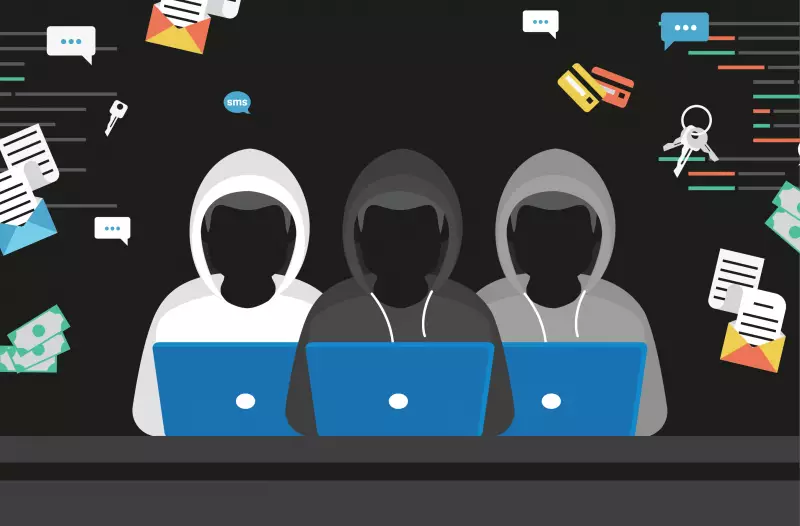Difference Between a White Hat, Black Hat, and Gray Hat Hacker
Table of Contents
- By Greg Brown
- Published: May 30, 2023
- Last Updated: Jun 08, 2023

Hackers have stepped up their game in recent years, attacking everything from local cash registers to government infrastructure. Brute force technologies use complex algorithms, hacking anything from encrypted passwords to coding. Flaws are found and exploited in cryptographic libraries, the Windows operating system, and OpenSSL, which resides in nearly every server on the planet.
Modern hackers are classified into three groups, with monikers dating back to the 50s. The Black and White Hat symbolism was derived from the shoot-em-up westerns of American culture. Black Hats were always the bad guys, and White Hats were the good guys who saved the day.
- White Hat Hackers are known to be ethical techies using their skills for positive results. Large corporate entities often employ White Hats to find network, application, and operating code vulnerabilities. These hackers are usually employed as security consultants or penetration testers. White Hat Hackers follow four rules: 1) Stay within the law, 2) Determine the scope and work within the client’s boundaries, 3) Report all vulnerabilities 4) Respect the client’s data at all times.
- Gray Hat Hackers operate between ethical hacking and outright malicious intent. Gray Hats may exploit vulnerabilities they find or report them to authorities. The constant struggle between good and evil is always on the mind of Gray Hats. These hackers are the modern-day Robin Hood, willing to forgo riches (most of the time) for the greater good.
- Black Hat Hackers choose to leverage vulnerabilities to their advantage. Black Hats spearhead a global scourge of exploiting computers and networks for personal gain. Financial systems, corporate data, and government infrastructure are under constant attack. Black Hats are skilled at what they do, often offering their services to the highest bidder on the Dark Web. No regard for authority is the signature of a Black Hat Hacker.
What is Color Coding?
Hacking began its ominous path in 1878; Yes, 1878, two years after Alexander Graham Bell invented the telephone. A group of teenage boys was “supposedly” kicked out of the switchboard room for intentionally exploiting a technical loophole to misdirect and disconnect client phone calls. After the incident, only women were allowed to be phone operators.
Jumping ahead nearly 100 years, modern hacking began with the US Air Force, ordering security testing of their time-shared computer systems. This is considered the first Pen-Testing technique.
John Draper, known as Captain Crunch, is considered the first hacker. Without the high-tech tools available today, Draper used a toy whistle from a box of Captain Crunch cereal to make free local and long-distance calls. In the 70s, telephone lines were analog, with specific frequencies used to make calls. Draper took advantage of the flaw with his whistle.
As time and hacking evolved, the spectrum of colored hacking expanded. The landscape now includes green, red, and blue hackers trying to differentiate themselves from good and bad.
- Green Hats are new to the business and eager to learn
- Microsoft employs Blue Hats to find vulnerabilities in their code
- Red Hats target the Linux platform
Whether these colors and hackers remain in the cyber security lexicon remains to be seen.
What are the Motives for Hacking?
Motivation drives people to achieve their goals and make positive changes for themselves or their families. Fear is a powerful motivator if not controlled correctly. Black Hat Hackers approach a network or computer system intending to do harm and nothing else. Law enforcement and those investigating malicious hacking know the mechanics and method, but little is known of their motivation. Money is not always the driving force; sometimes, it may be revenge on government policies and programs or those same family members.
We may never know the exact motivations of a hacker who wants to bring down pipelines and corporate structures.
At the other end of the spectrum, White Hat Hackers are motivated by improving the companies they work for. White Hats use their skills to create long-term work opportunities for themselves and their families. White Hats are ethical individuals who bring money and family motivations to the job.
Gray Hats are squarely in the middle; they have not quite figured out the difference between good and evil. Their motivations always point to the good side but are easily swayed to the Dark Forces. The impetus for their actions is often thrill and excitement. However, money is always in the back of a Grey Hat’s mind. Compare a White Hat’s motivations and ethical decisions; they can be easily turned in either direction.
White Hat Hackers are ethical in their endeavors, using sophisticated skills on client networks and computers to find vulnerabilities. The motivation is to defend against malicious Black and Gray Hat hackers. Motivations come from a deep-seated need to help in cybersecurity, Pen Testings, analytics, and more. White Hats use every tool at their disposal to counteract the damage caused by other hacking groups. There is never a desire to avoid “doing the right thing.”
Hackers get their bad reputation from Black Hats. Motivations are aimed at money, possessions, revenge, and often pure destructive fun. Black Hats exploit vulnerabilities in networks, computer systems, mobile phones, and anything electronic. The bigger, more complex the system, the quicker Black Hats accept the challenge. Black Hat Hackers use phishing, malware, espionage, and stealing identities to reach their goals.
Should We Trust Gray and Black Hat Hacking Groups?

Successful organizations around the globe are built on partnership and trust. Hacking groups are none of those! New and technologically advanced tools are touted as unbreachable code; not even the best hackers can break.
Email Phishing attacks are considered by many to be the simplest form of hacking. Yet, in the modern era of advanced tools, phishing remains highly effective at installing malware on a target system. Google blocks nearly 100 million phishing emails daily; the statistics gleaned from this constant bombardment are startling.
- 45.56% of emails sent in 2021 were spam
- 90% of phishing attacks through messaging are sent via WhatsApp
- 40% of cyber-attacks against businesses in 2021 were phishing attacks
- For the finance industry, the percentage of phishing attacks rose to 46%, and energy rose to 60%
The largest hack ever recorded, Saudi Aramco, was initiated by a single employee opening a phishing email.
















